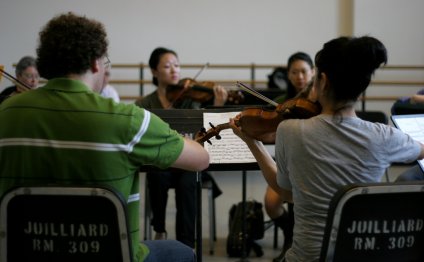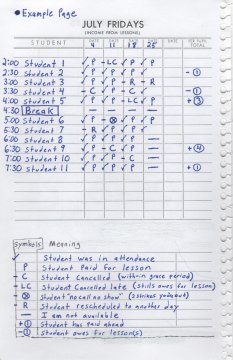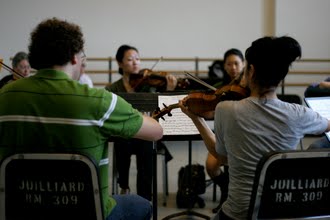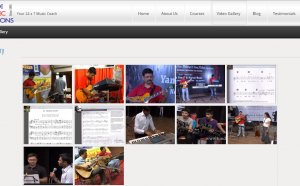
Teaching Music lessons
 2001 percussion alum Ben Johnston has been holding it down on the drum kit for Self-Evident and Lovely Dark for a number of years now. Both bands have seen critical acclaim and have toured nationally and internationally for years. When Ben isn’t on the road, he is making a full-time living off teaching private lessons and is currently working on publishing his first drum instruction book.
2001 percussion alum Ben Johnston has been holding it down on the drum kit for Self-Evident and Lovely Dark for a number of years now. Both bands have seen critical acclaim and have toured nationally and internationally for years. When Ben isn’t on the road, he is making a full-time living off teaching private lessons and is currently working on publishing his first drum instruction book.
Through teaching private percussion and drum set lessons for the last 13 years, Ben has learned a ton. He was kind enough to share some key tips for those of you who are interested in teaching private lessons yourself. Take it away Ben!
5 Tips for Students Interested in Teaching Private Lessons by Ben Johnston
1. Each lesson should be tailored to the specific needs of the student.
Teaching groups and teaching private lessons are very different. It is hard to give individual attention to every student in a classroom setting. When there is a set curriculum for students to follow, some will be on top of it, or beyond, and others will lag behind. In private lessons you have the luxury to step outside of the rigidness of a curriculum and teach to each student’s priorities, interests, strengths and weaknesses directly. At the beginning of every lesson I ask my students what their priorities are for the week. Do they have a piece for school band they need to work on, or something specific that they are having troubles with that they’d like to address first? If not then I’ll ask them if they had any questions or troubles with the material covered in the last lesson. If they say no, then I’ll have them first demonstrate the material and then proceed from there. If they are not currently having any troubles or questions with any prior material then I’ll ask them what aspect of their playing would they like to move forward on, e.g., their technique, their reading ability, a new song or groove they’d like to work out and so on. I try to have them make the directional decisions because they are more likely to feel (and be) in control of their own progression as a musician, and in turn be more likely to practice and to have fun. I’m not in there trying to make carbon copies of myself, I’m just serving as a guide to help each student discover their own musical path.
I’m not in there trying to make carbon copies of myself, I’m just serving as a guide to help each student discover their own musical path.
2. Keep good notes and records.
This is true for both financial reasons and for keeping track of each student’s progress. I use a book called “Williams Music Teacher’s Bookkeeping Book” published by Thomas Music Company. It’s specifically designed for music teachers and I’ve created my own system for keeping track of attendance and payment that I’ll share with you here (attached). As for keeping track of a student’s progress I like to take short notes in a separate notebook as to what material was covered at each lesson. This way I have a history of progress I can refer back to for myself, the student, and, if applicable, the parents. I also encourage my students to keep a log of their practice time. One really easy way to do so is by taking a single stave in the back of their manuscript book and divide it into 7 individual boxes with an 8th box at the end for a total amount of minutes. Above each box write the dates between each lesson and ask the student to write in how many minutes they practiced on each day. If they didn’t practice at all then they can leave it blank or x it out. At the end of the week I have them add up all their minutes and write it in the ‘total box’ at the end. This way we all have a record (student, teacher and parent) of how much time is actually being put in by the student. If the parent ever asks me “Why is my son/daughter not improving?” I’ll first refer to their practice sheet, chances are there’s a lot of empty boxes. If I have a student who doesn’t practice on a consistent basis I make sure to be honest with them and/or the parents. Sometimes I’ll add an appropriate incentive if they reach a certain predetermined amount of practice minutes, e.g., a pack of gum, a sticker, 50¢, etc.
YOU MIGHT ALSO LIKE



Share this Post
Related posts
Free Music lessons for Kids
Nikia Cliff II, 6, throws paper airplanes with his Major Chords for Minors piano instructor, Bruce Leaman, after Cliff s…
Read MoreHindi Music lessons
Ragas form the core of Indian Classical Music. With their characteristic aaroha (ascend) and avaroha (descend), and pakad…
Read More
 Music lessons are a type of formal instruction in playing a musical instrument or singing. Typically, a student taking music lessons meets a music teacher for one-on-one training sessions ranging from 30 minutes to one hour in length over a period of weeks or years...
Music lessons are a type of formal instruction in playing a musical instrument or singing. Typically, a student taking music lessons meets a music teacher for one-on-one training sessions ranging from 30 minutes to one hour in length over a period of weeks or years...










